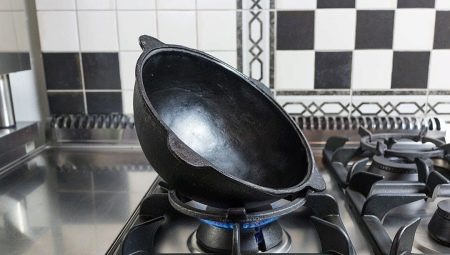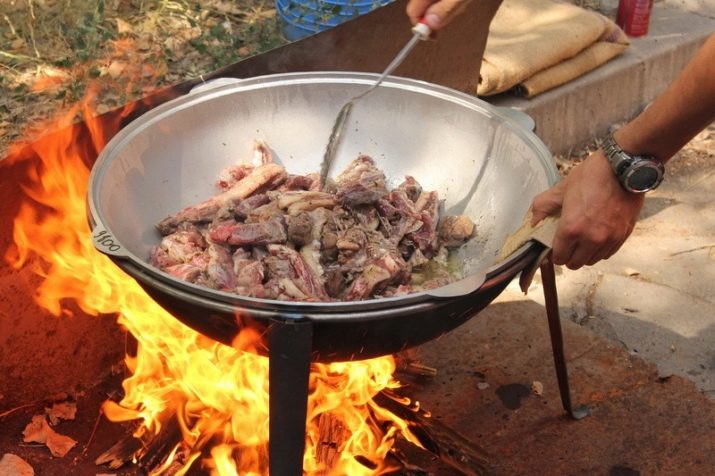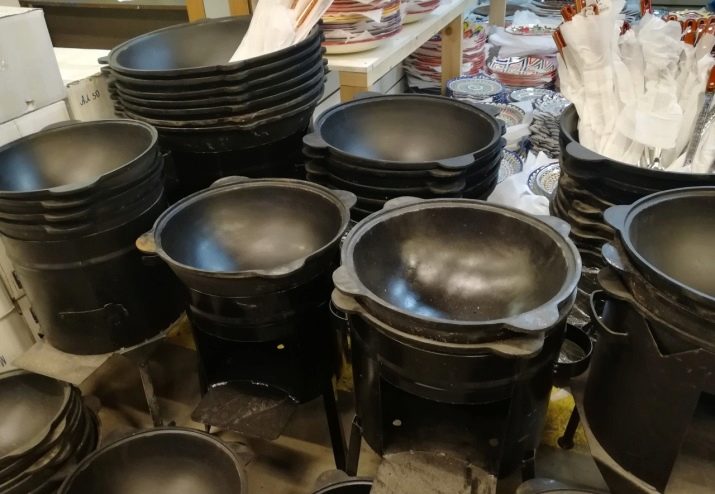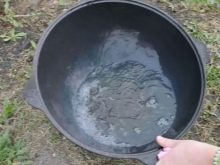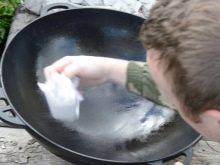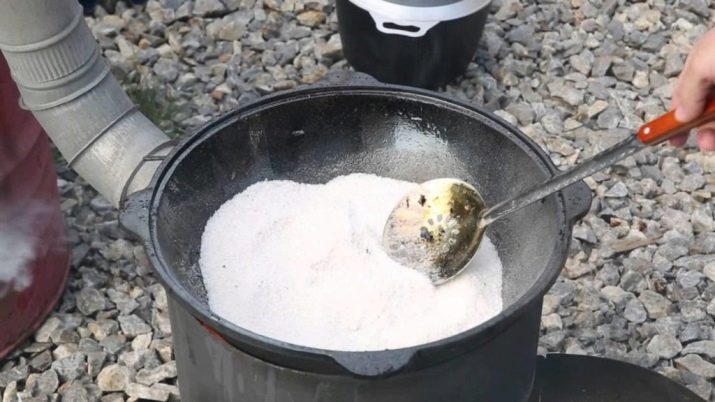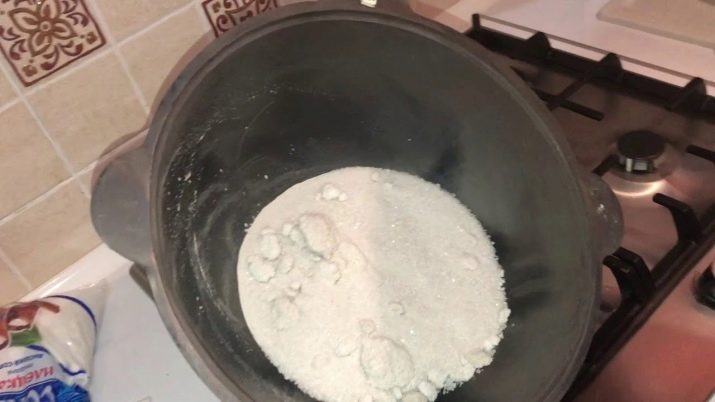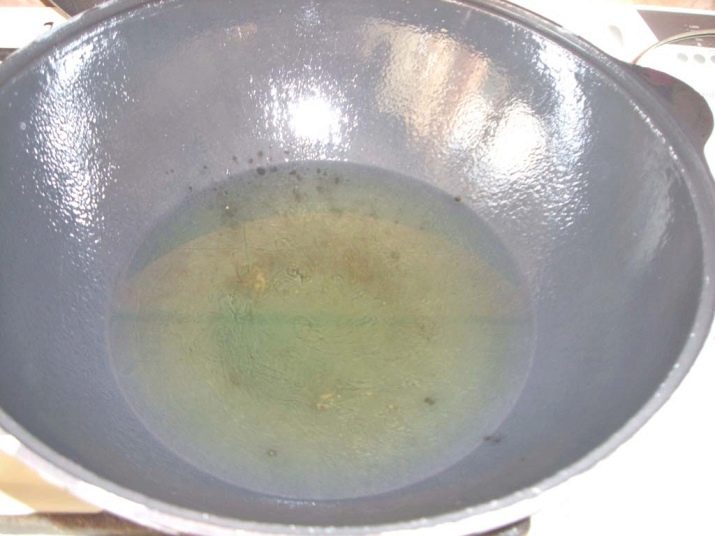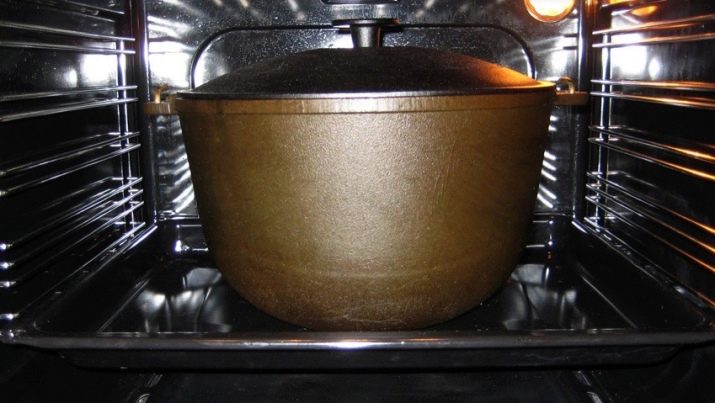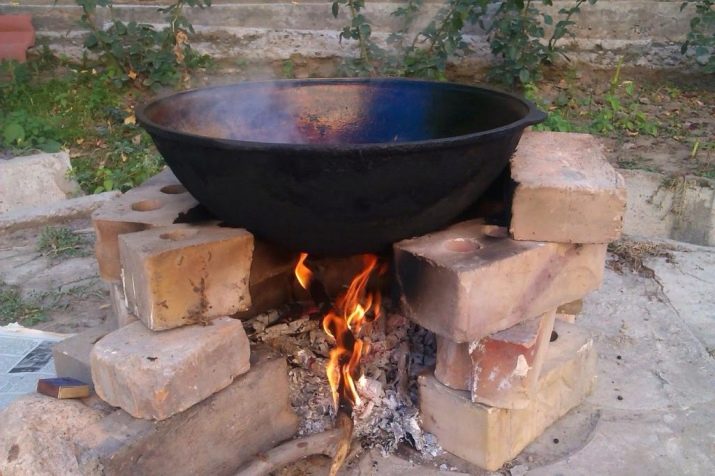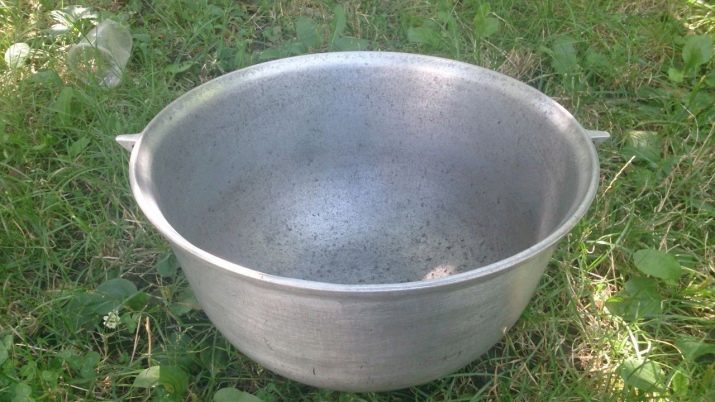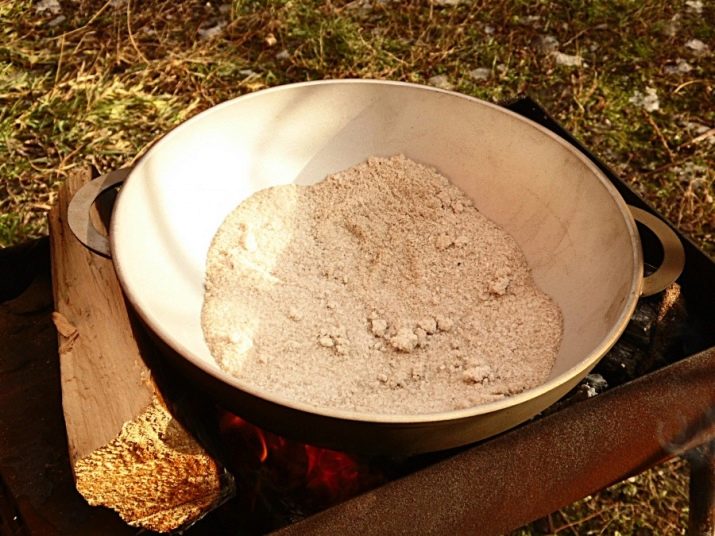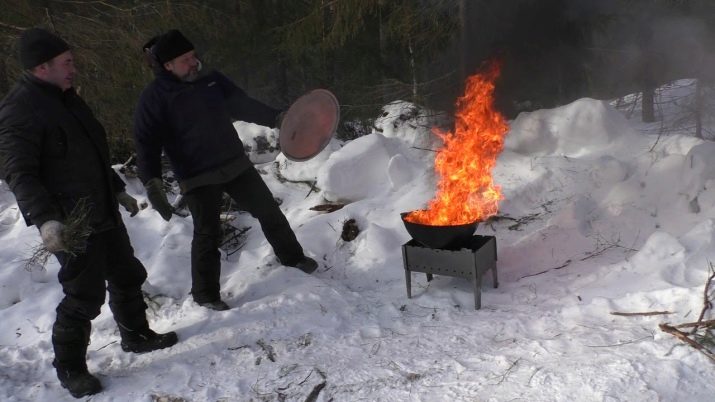Kazan is a popular tool for quenching and languishing vegetables and meat. It differs from ordinary pots and pans in a semicircular shape, which evenly distributes heat along the walls - this allows you to more efficiently process the entire volume of food. In this article you will learn how to properly ignite a cauldron, as well as how to prepare a new cast iron cauldron for the first use.
Purpose of the procedure
Most often the cauldron is made of cast iron. If new kitchen utensils and dishes made of other materials can be easily washed and immediately used, the cast iron needs special preprocessing procedures.
The so-called roasting or calcination is necessary for the cauldron because of the peculiarities of its production.
In the manufacture of cast iron accessories in factories actively used technical grease that tightly eats into the walls of dishes. This grease retains the appearance of the product, protects it from corrosion and the formation of chips. When heated, this lubricant emits an extremely unpleasant smell, not to mention the fact that it simply harms all products and makes them unsuitable for human consumption.
Heat treatment allows you to remove most of the lubricant and prepare the container for use at home.
Methods of preparation of cast iron cauldrons
If we briefly describe the procedure for preparing a cast iron cauldron, it consists of several steps. The calcination methods themselves will be discussed in more detail below.
- Before use, be sure to wash the walls of the container under warm running water. For a more thorough cleaning, it is better to choose soft products - gels, liquid soap.
- Dry and dry thoroughly.
- Then the calcination procedure itself takes place. At the end of the procedure, it is worthwhile to allow the tank to dry out in natural conditions, do not allow the ingress of water.
- Soot, dirt and excess oil are removed using rags, napkins and soft cleaning agents.
- After calcining and cleaning the cauldron it is recommended to treat it with any edible oil. It fills the holes in the porous surface of the cauldron, which creates a smooth non-stick coating.
- As soon as you treat the cauldron with oil, it should be thoroughly washed again with warm water. Then you will only have to wipe the tank, and it will be ready for debut use.
There are several proven methods of how to high quality calcined cauldron. No matter which method you chose, The calcination and impregnation of the device with oil should be carried out as early as possible - preferably on the very first day of purchase.
The method of burning cauldron with salt
This option is suitable for calcining both in the open air and at home. Most often, this method is resorted to in the conditions of an apartment. For the procedure only coarse ground salt will do - the larger it is, the more useful the procedure will be for the cauldron.
The following describes the step-by-step instructions for such annealing.
- At first it is worthwhile to just thoroughly rinse the cauldron under normal running water. Wash not only the inner, but also the outer walls, pay special attention to the bottom of the cauldron.
- Dry wipe all tank walls with a dry cloth.
- Place about 2.5 pounds of salt in the bottom of the tank. The amount can be increased depending on the size of the cauldron.
- Install the device on a small fire and ignite for 1–2 hours.
- To learn about the readiness, watch the state of salt. If the cauldron is fully hardened, it should turn rusty or brown.
- After the salt is colored, turn off the heat and allow the cauldron to cool slightly. After that, wipe with the same salt all the walls of the cauldron. In the future, it can not be used for the same purpose - this salt has already been saturated with oil.
Since this method involves roasting to a greater degree of the very bottom with the help of salt, a conventional electric stove is suitable for this procedure, which provides heating of the bottom area.
Method of processing cauldron with vegetable oil
The oil is not used directly in the process of calcining the cauldron, however, it is necessary after the procedure itself. The fact is that the cast-iron tank, after dry roasting in the oven, on the fire or with the help of salt, needs good lubrication for high-quality work. This grease primarily protects the device from rust, and also makes the porous surface of a cast-iron cauldron smooth and non-stick.
The sequence of steps in the procedure for treating the instrument with oil is described below.
- Olive oil is usually used, but if it is not, then butter and sunflower are suitable, but not technical.
- After the calcination procedure itself, allow the device to cool slightly, and then pour about a liter of oil into the container.
- Put the tank on fire.
- After the oil begins to boil and bubble, gradually incline the container so that the oil flows evenly onto all the walls of the cauldron. You can help yourself with a scoop to reach hard-to-reach places and protect yourself from the risk of getting burned.
- After all the walls of the container are covered with oil, place it in the oven (before that, heated to 200 degrees Celsius).
- Burn the device is within 1.5-2 hours.
- Turn off the oven and allow the tank to stand for a while until the oil is completely dry. If after drying on the cauldron still remains a little oil, remove it with a cloth, water or detergent.
Do not rush to cooling or washing the cauldron. Pouring cold water into a heated cauldron is prohibited - so you get not only a cloud of smoke, but also a chance that the tank will crack.
The method of calcination cauldron in the oven
This method is not recommended to use if you have the opportunity to ignite the cauldron differently.
The fact is that during the treatment of the cauldron in the oven, a huge amount of toxic fumes from technical oil is released.
In order not to get poisoned with these vapors, provide a constant supply of fresh air in the kitchen, and a good range hood will not hurt much. The process of such annealing takes place in several stages.
- Thoroughly rinse and dry the cauldron.
- The oven is heated to an optimum temperature of 200 degrees, not more.
- Place the cauldron inside the oven, close the door.
- Very soon you will notice how dark smoke starts to emanate from the device. Opening the door to exit the smoke is not worth it - in modern ovens there are special openings through which it can safely go.
- Heat the container until the smoke disappears completely. It usually takes from 1 to 2.5 hours depending on the quality of the oven and the size of the cauldron.
- Allow the cauldron to cool slightly, then simply wash it under cool water. Do not use detergents, soot you can remove with a cloth or sponge.
Method of firing cauldron on the fire
In this case, the cauldron is exposed to high temperatures not only in the bottom area, but also in the area of all the walls.
That is why the procedure itself should take place only in the fresh air - during its course just a huge amount of acrid smoke is released, which can lead to poisoning and suffocation.
Here the step by step procedure is as follows:
- Rinse the container thoroughly with light detergents or just under a strong stream of running water;
- dry the cauldron and wipe with a dry towel;
- place the appliance on an open fire, while keeping the heat always at about the same level;
- wait for about 3 hours until the acrid smoke disappears;
- Allow the containers to dry themselves, then rinse them with warm running water and dry them;
- fire must be extinguished, in the next few uses it will be harmful to health.
Features of calcination of aluminum products
Aluminum cauldron is a budget option for extinguishing and cooking. The peculiarity of such models is that Because of the good thermal conductivity, the walls of the cauldron warm up very quickly and cool quickly. In addition, these models are much easier to cast iron. Aluminum cauldrons are not suitable for long cooking, for example, for languishing food (for this metal it is difficult for a long time to maintain one certain level of heat).
Aluminum containers are not calcined for the same purpose as cast iron. Here the thing is that aluminum during heat treatment emits special oxides, which form a dense protective film on the surface of the model. This film protects dishes from scratching, and also serves as a good non-stick coating. Despite these seemingly positive moments of cooking in aluminum cookware, there is one negative.
Aluminum is an extremely low-melting metal, so a cauldron made of this material can simply be deformed during long-term calcination.
The following recommendations should be followed during the calcination of the aluminum cauldron.
- If you chose to roast the cauldron on an open fire, it is worth choosing the dampish logs to achieve a small but sufficient temperature. They inflame worse, but they smolder longer, creating a large amount of optimal heat.
- Constantly monitor the deformation of the device, as soon as some wall begins to melt and settle down - immediately remove the device from the fire.
- Aluminum cookware does not need the same long annealing as cast-iron. There will be enough one and a half hours even with the largest cauldron.
- In the case of the calcination of the aluminum boiler does not matter which method to choose, the main condition here is not to exceed the permissible temperature bar.
- After calcining, allow the cauldron to settle, then rinse with light detergents.
Before you burn a new aluminum cauldron, make sure he doesn't have his own non-stick coating yet. Otherwise, such a procedure may, conversely, lead to the destruction of the protective layer. Moreover, keep in mind that Aluminum devices do not rust, and therefore do not need additional processing with vegetable oil.
Tips and security measures
When calcinating a cast-iron or aluminum cauldron, the following cooking recommendations should be followed, as well as safety advice at the time of the firing procedure.
- Heat treatment of this kitchen appliance is recommended to be carried out in the open air, and not in the walls of the house. In a closed, albeit ventilated area, the chance of poisoning with poisonous fumes and smoke from evaporating oil is too great.
- Avoid sudden changes in temperature. A cauldron heated to heat can never be dipped in cold water. So he can not just crack, and burst and cause injury to you and your loved ones.
- Firing should be carried out in a place inaccessible to children - they can not only be poisoned by poisonous fumes, but can be scalded with oil or burned on the heated walls of a cauldron. All this will lead to severe burns and stress.
- Before buying an appliance, be sure to consider the size of your hob, oven or cooker, if you decide to use these calcination methods. The cauldron should fit in the hole of the oven and have access to the air.
- For the first experience, it is best to choose an aluminum model - it is easier to care for it, it heats up faster and cools down.
- When cleaning the cauldron at home it is not recommended to use aggressive cleaning products. Regardless of the material of the container, they can cause irreparable damage to the floor or walls.
- We do not recommend even minimally moving the device during calcination. You risk injury and burn.
- In no case do not cover the device with a cloth or try to knock down fire with cloth objects. Also, do not try to put out the fire with flour.
- After each cooking the cauldron should be washed and wiped with a cloth. If food suddenly begins to adhere to the walls or bottom of the cast-iron model, be sure to repeat the procedure of soaking the cauldron with oil.
Some housewives are faced with such a problem that the oil in the cauldron begins to literally burn. This usually happens when an unscrupulous approach to security rules.
The fact is that the cauldron should be ignited at a temperature of up to 200 degrees, upon reaching a temperature of 230 degrees some vegetable oils may very likely start to burn.
If a fire does happen, try to follow the following instructions.
- Remove the heat source. Extinguish the fire as quickly as possible, remove the gas or turn off the stove. To quickly put out the fire, keep the ground nearby.
- In order for the oil to stop burning, you need to block access to oxygen. To do this, cover the cauldron with a metal baking sheet or another metal object that can cover all the container from above.
- In an emergency, use a fire extinguisher. Never try to pour water on a hot cauldron.
In the next video you will learn how to easily ignite a new cauldron.
